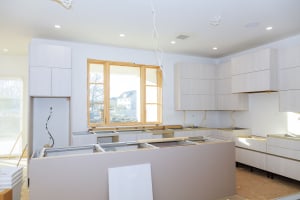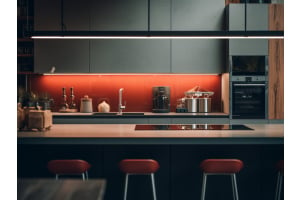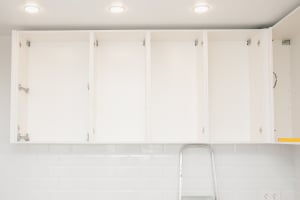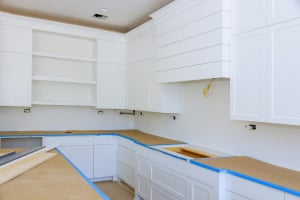Many kitchens have an unused space between the top of the wall-mounted cabinets and the ceiling–and one of the easiest solutions is to opt for tall kitchen cabinets, custom-manufactured to your sizing requirements!
However, if you are calculating the cabinet refacing cost for your kitchen or have recently remodeled your space with kitchen cabinet installation, there are several other excellent ways to make this space a design feature.
Why Decorate the Space Above Kitchen Wall Cabinets?
The gap between the top of your cabinets and the ceiling can quickly gather dust or become an area where miscellaneous items are placed out of reach and forgotten about. Repurposing unused areas within your kitchen can incorporate details or styling to create a sense of unity and cohesion, complementing the color scheme, decorating style, or theme of your kitchen cabinets and appliances.
As we’ve mentioned, an option is to install taller upper kitchen cabinets on the wall, whether to increase the workspace area and elevate the head height of your wall-mounted units or to avoid creating a gap. Another great way to maximize the impact of tall kitchen units is to fit a secondary open shelf below, a perfect space to store herbs, glassware, or other display items.
Let’s look at some of our favorite ways to make empty space stand out or provide a practical benefit to improve the aesthetic of your kitchen décor.
Adding a Trim Above Wall-Mounted Kitchen Cabinets
If the space over your cabinets is too small or slim to be useful, you can install a trim, either in a color and material that is consistent with your cabinetry, in a shade that matches your walls, or in a contrasting texture and finish. A trim can make a freestanding kitchen cabinet look like a fully built-in unit, integrating your cabinets with the wall space and providing a finished, modern look.
Alternatively, you might consider adding paneling or boxing above the cabinets, a trick often used by architects and interior designers to conceal ducting or pipework while ensuring there is sufficient airflow and that any vents remain accessible for safety reasons. Color-contrasting trims can be based on the tone of the countertop, floor tiles, or splashbacks, creating a pop of style that coordinates all of the shades and hues within your kitchen.
Using Empty Space Above Kitchen Cabinets for Storage
Depending on the ceiling height in your kitchen, this empty area can be a practical and beneficial place to store items, such as wine bottles, utensils, or display items. Open shelving is a good opportunity to display visually attractive items such as glassware, collectibles, or serving sets. You can also enclose the storage space to improve the storage capacity within your kitchen and move any items you wish into your upper-level units.
Larger kitchens with a more generous space above the wall-mounted cabinets can accommodate either open shelving or a stacked secondary row of cabinets, creating a sense of proportion and elongating the room. Many homeowners use the upper storage level for items they use less often or to keep sharper utensils far out of reach of children.
Higher shelves can also act as a display point for other items, such as plants. Vines and herbs work well and thrive in kitchens, which tend to be warmer and more humid than other rooms in a home during cooking. Dried herbs and English Ivy are also classic additions to a home with a vintage aesthetic, or they can add a gentle touch to more modern kitchen spaces.
Painting the Gap Between Kitchen Cabinets and the Ceiling
Finally, you can utilize or disguise the space between your ceiling and kitchen cabinets by adding paint or hanging artwork with colors that fit in well with the rest of the design scheme within your kitchen.
Painting the wall behind the same color as the cabinet doors makes the space less noticeable and blends the cabinet color upward. Using a different color to match other accents in your kitchen can bring more brightness and energy to the room–a neutral, pale shade is ideal if you wish to boost the light in the room!













